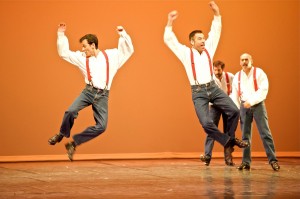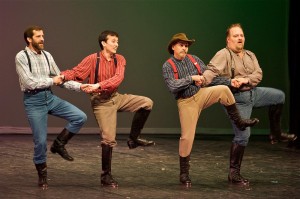As the first high notes of fiddle fill the air, a group of twelve men in jeans and flannel shirts begin to clap rhythmically. A banjo joins the fiddle, and the men are off—stomping out a strong beat against the wooden floor, their toes and heels hitting the boards in a driving thump-clackity-thump as legs fly merrily. These are the Barbary Coast Cloggers, an all-male clogging ensemble known for their energetic and upbeat performances.
If America is, as the saying goes, a “melting pot,” then clogging is one of the earliest fusions drawn from that steaming cauldron. Once known as “American step dancing,” clogging is the first folk dance form of the United States. Ian Enriquez, Artistic Director of the Barbary Coast Cloggers, explains, “When the country was first formed, people from different countries would play instruments together, and you would have this blend that included Scottish and Irish fiddles, German mandolins, and African banjoes.” Immigrants and Native Americans mixed disparate musical styles, instruments and dance moves, teaching each other steps and notes as they went. From this mixture, our ancestors created bluegrass music and clog dancing. Contemporary audiences may be more familiar with tap-dancing, clogging’s highly syncopated off-shoot. Clogging, born in the Appalachian Mountains, retains a more relaxed, bucolic feel. Musing on the dance’s early formation, Enriquez says, “In a national history loaded with division, slavery, and discrimination, it’s uplifting to imagine people from such different backgrounds and cultures coming together and partying.”
In this respect, the Barbary Coast Cloggers remain true to the roots of the genre: the group itself is composed of men from diverse backgrounds and age ranges. The guys who perform in the Barbary Coast Cloggers ensemble have a wide range of day jobs: therapists, school principals, police officers and even piano tuners. But, like those early Appalachian cloggers, these men are brought together by a shared love of music, dance and camaraderie.
The Barbary Coast company is unique in that it is the only all-male traditional clogging group in the country. They began performing in 1981, an off-shoot of The Foggy City Squares, a gay square dance group dating back to the ‘70s. Though the current company is a mix of gay and straight men, the group’s all-male cast remains a part of their appeal. Audiences love the Barbary Coast Cloggers, says Ian Enriquez, because they’re responding to that boisterous masculine energy. Whereas some choreographers may portray masculine “strength” in dance using anger or violence, Enriquez is inspired by the “joyful and rambunctious” spirit of male dancers like Gene Kelly. For the Cloggers, Enriquez says, “Everything we do is about the joy of dance, and the audience responds to that.”

Photo by Holly Ireland
Sharing a love of dance
If the men of Barbary Coast Cloggers have an obvious love for dancing, then it’s no surprise that they love to share this joy with others. Though winter is generally a quiet time for the company, they regularly participate in several festivals throughout the year: the San Francisco Ethnic Dance Festival in June; the Bay Area Tap Festival in August; and the San Mateo Harvest Festival in November.
Year-round, the Cloggers also teach classes, open to dancers from all ages and walks of life, ladies included. Clogging is an easily accessible dance for newcomers: the distinctive metal taps can be glued to any comfortable pair of shoes. Sunday nights at the ODC Dance Commons, Ian Enriquez leads a two-hour lesson that gets progressively harder, encouraging students to push their skills and learn from advanced dancers. In the new year, the company will expand their class offerings, leading advanced classes on the weekends and beginning/intermediate classes on Monday nights at City Dance. Enriquez explains, “People like to have their weekends free. With weeknight classes, we can serve more working folks. I’m looking forward to teaching more people how to clog.”
The group also shares a dedication to charity work, and has been acknowledged by the City and County of San Francisco for its charitable contributions, which have helped raise thousands of dollars for local causes, including AIDS support organizations, MS and breast cancer research and the arts. Since its formation, the Barbary Coast Cloggers have focused their time and energy on providing entertainment at fundraisers in San Francisco, including a commitment to the Sundance Stompede and the Richmond-Ermet Pediatric AIDS Foundation. For one memorable show, the Cloggers donned Santa suits and joined Nancy Sinatra on-stage for “These Boots are Made for Walking,” a number that brought the audience to their feet. As Enriquez puts it, “We don’t turn down gigs for non-profits. It’s just a matter of two things: if we have enough dancers available for the evening and they have a good dance floor, then we can do it.” Of course, it’s a special bonus to perform a show that both entertains and educates, allowing the group a chance to speak about clogging’s rich history.

Photo by Holly Ireland
Clogging with a modern sensibility
Though clogging has a long tradition in bluegrass music, the Barbary Coast Cloggers recognize that folk dance is a living tradition, with room for growth. In addition to their traditional repertoire, the men of Barbary Coast dance to many types of music, from contemporary hip hop to pop hits, and even tunes from other parts of the world, like Hawaii and Algeria. As Artistic Director, Ian Enriquez welcomes the challenge of honoring the company’s traditional heritage, while also experimenting with the art form. In a daring move, the group performed to “Gangnam Style” at this year’s Harvest Festival. A pop music phenomenon from South Korean rapper PSY, the video for this song has given new meaning to the phrase “viral video.” With its immense popularity (garnering the highest single video viewing count on YouTube, at 867 million, as of November 2012), Enriquez says, “It was a lot of pressure, to do our own version. But the crowd loved it.”
Under Enriquez’s leadership, the Barbary Coast Cloggers have performed contemporary pieces at the Fresh Meat Festival and at the Nations of San Diego International Dance Festival. Enriquez admits that it can be nerve-wracking to walk the line between traditional and contemporary folk dance. But, bolstered by warm responses from festival producers and audiences, the company—and the dance style—will continue to evolve. Enriquez says, “I have challenged the artform, but that’s part of the tradition: to bring in other forms of movement and combine dance steps from mixed backgrounds.” While the group will continue to honor the company’s traditional heritage, Enriquez is encouraged by the success of their modern pieces. “It’s fun to celebrate all the different things we can bring in and help it grow.”
Always looking for a new inspiration as a choreographer, Ian Enriquez has found insight in the emotionally rich music of Los Angeles composer Shawn Kirchner’s Meet Me on the Mountain, a suite of bluegrass and soulful country inspired by the movie Broke Back Mountain. The Barbary Coast Cloggers have premiered dances to two of these songs, wherein Enriquez pushed himself to create more square dance formations. With these successful works under his belt, Enriquez faces a unique challenge. Unlike the other songs on the album, the final song best suited for clogging directly addresses gay marriage. For this reason, Enriquez is understandably nervous. The company’s history is closely connected to the gay community, yet their work remains non-political, and definitely non-romantic. With an all-male company, the Barbary Coast Cloggers rarely do “partner work,” like one sees with co-ed groups. Instead, the company changes partners without end, switching and pairing only briefly. The prospect of creating male-to-male partner work for Kirchner’s song is both exciting and terrifying. Enriquez is ready for the challenge, saying “We just have to confront it and perform it and see what comes of it.” With a track record of crowd-pleasing and critically-acclaimed performances, it seems likely that the Barbary Coast Cloggers will rise to the test with their unique brand of joyful exuberance.
To learn more about the Barbary Coast Cloggers, visit their website at www.barbarycoast.org.
This article appeared in the January/February 2013 issue of In Dance.


